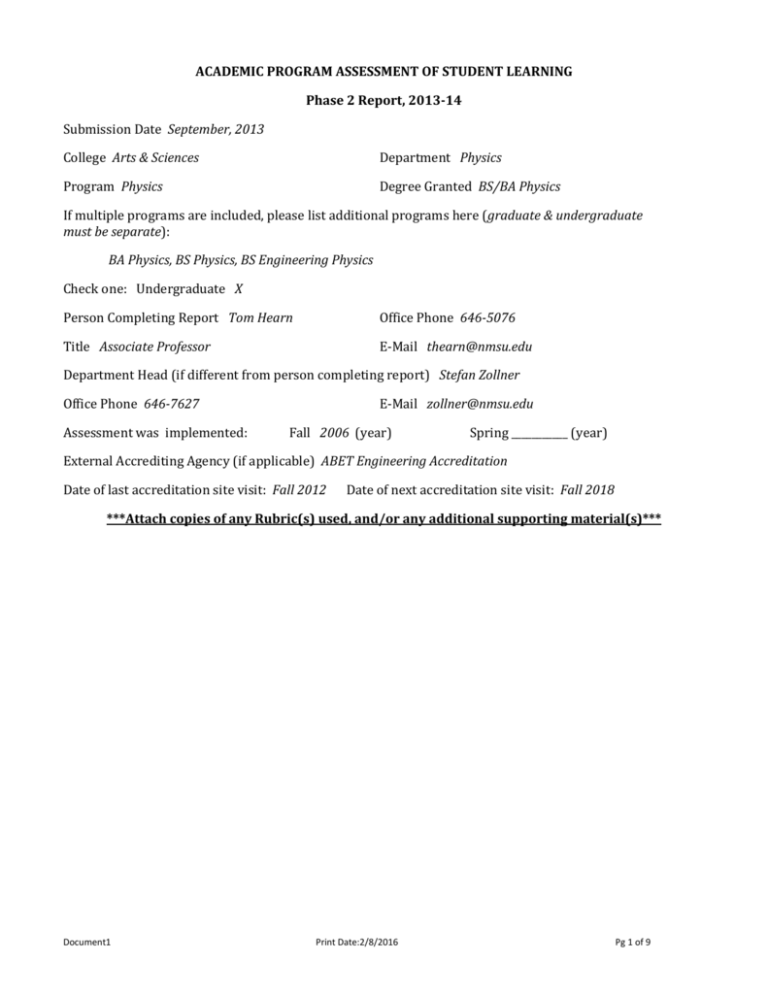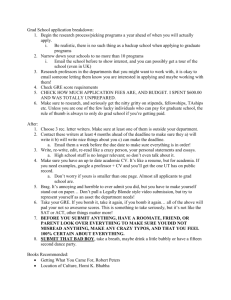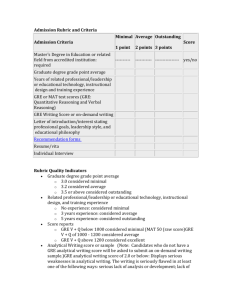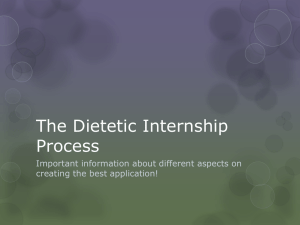academic program assessment of student learning
advertisement

ACADEMIC PROGRAM ASSESSMENT OF STUDENT LEARNING Phase 2 Report, 2013-14 Submission Date September, 2013 College Arts & Sciences Department Physics Program Physics Degree Granted BS/BA Physics If multiple programs are included, please list additional programs here (graduate & undergraduate must be separate): BA Physics, BS Physics, BS Engineering Physics Check one: Undergraduate X Person Completing Report Tom Hearn Office Phone 646-5076 Title Associate Professor E-Mail thearn@nmsu.edu Department Head (if different from person completing report) Stefan Zollner Office Phone 646-7627 Assessment was implemented: E-Mail zollner@nmsu.edu Fall 2006 (year) Spring ___________ (year) External Accrediting Agency (if applicable) ABET Engineering Accreditation Date of last accreditation site visit: Fall 2012 Date of next accreditation site visit: Fall 2018 ***Attach copies of any Rubric(s) used, and/or any additional supporting material(s)*** Document1 Print Date:2/8/2016 Pg 1 of 9 PROGRAM OVERVIEW Briefly summarize your assessment implementation and findings from the prior year, or prior years. How did past assessment activities and/or findings affect your assessment for the current academic year? If applicable, discuss any past curricular or instructional developments/changes that influenced this assessment – e.g. you implemented changes based on assessment findings, and this is a reassessment to determine impact of those changes; your previous assessment brought to light new/additional questions that you sought to addressed through this assessment; your previous assessment indicated no changes were needed, so you are assessing a different outcome this year; etc. NMSU Mission: New Mexico State University is the state’s land-grant university, serving the educational needs of New Mexico’s diverse population through comprehensive programs of education, research, extension education, and public service. Academic Program Mission: The academic mission of Physics at New Mexico State University is to offer a degree that combines highquality science and physics programs to best prepare our graduating students for careers in state-of-theart industry or to move on to advanced study in engineering or physics Academic Program Goals: Guiding undergraduate students in physics, engineering physics, and other majors to graduation supports the top goal of the university: “Graduation is Goal #1". Academic Program Objectives: Objective 1: Competitiveness. Graduates are competitive in internationally-recognized academic, government and industrial environments; Objective 2: Adaptability. Graduates exhibit success in solving complex technical problems in a broad range of disciplines subject to quality engineering processes; Objective 3: Teamwork and Leadership. Graduates have a proven ability to function as part of and/or lead interdisciplinary teams. Document1 Print Date:2/8/2016 Pg 2 of 9 CURRENT YEAR – REPORT ON ASSESSMENT ACTIVITIES & FINDINGS Direct Student Learning Outcome: Students will be able to use the existing scientific understanding and models to solve physics problems in the subjects of Classical Mechanics, Thermodynamics, Electrodynamics, and Quantum Physics. Components of the Outcome (Components are the particular pieces that together create success on a given outcome. For example the key components of a speech could include content, organization, eye contact and delivery): Assessment of our student is done as part of the six required 400-level physics classes on the subjects of Classical Mechanics, Thermodynamics, Electrodynamics, and Modern Physics. In Spring 2012 the Physics Department began using the Educational Testing Service Physics Major Field Test as a component of our outcomes assessment. Describe Evidence Used to Assess Learning (student product) – if applicable and desired, you may attach student assignment/ instructions for assignment: Assessment of our students is done as part of the six required 400-level physics classes on the subjects of Classical Mechanics, Thermodynamics, Electrodynamics, and Modern Physics. Instructors are free to choose an appropriate measure of higher-level problem-solving ability; however one suggested method used by many instructors is to include on in-class examinations several questions in the course subject area taken from the Physics Subject test of the Graduate Record Examination. These questions are evaluated and reported separately from other examination questions and compared with a target score. Originally the target was the national average score on the GRE Physics subject test. In the future, the target will be set by the instructor since these instructor-selected problems do not necessarily reflect the full GRE examination. In Spring 2012 the Physics Department began using the Educational Testing Service Physics Major Field Test as a component of our outcomes assessment. This is a commercial test that allows comparison to normed data from other physics departments. To date we have conducted two of these tests. Indirect Student Learning Outcome (Optional): ASSESSMENT DATA: When did the assessment take place? This report includes courses taught up to the Spring 2013 semesters and the Physics Major Field Test conducted in Spring of 2013 as part of our Quantum Mechanics course. How many students participated in the assessment process? In the Fall 2012 and Spring 2013 semesters, over 100 student-assessments were done. Since some students may have been enrolled in more than one course, the number of individuals participating is smaller. Nine senior students took the ETS Physics Major Field Test. Please report student performance scores This table contains assessment data obtained from embedded GRE questions for the past 10 years. Course Number Title Semester Numerical Semester Assessment Tool Number of Students Results Goal Results / Goal 451 Classical Mechanics Spring 2004 2004.1 GRE 16 24% 43% 56% Spring 2005 2005.1 GRE 9 71% 43% 165% Document1 Print Date:2/8/2016 Pg 3 of 9 454 455 461 Document1 Modern Physics I Modern Physics II Electromagnetism I Spring 2006 2006.1 GRE 7 75% 43% 174% Fall 2006 2006.4 GRE 9 65% 43% 151% Fall 2007 2007.4 GRE 13 65% 43% 151% Fall 2008 2008.4 Homework 9 79% 79% 100% Fall 2009 2009.4 Homework 9 76% 81% 94% Fall 2010 2010.4 GRE 5 60% 65% 92% Fall 2011 2011.4 GRE 10 65% 69% 94% Fall 2012 2012.4 GRE 15 31% 65% 47% Fall 2004 2004.4 GRE 4 50% 43% 116% Fall 2005 2005.4 GRE 10 46% 43% 107% Fall 2006 2006.4 no report Fall 2007 2007.4 no report Fall 2008 2008.4 no report Fall 2009 2009.4 GRE 12 63% 65% 92% Fall 2010 2010.4 GRE 14 55% 49% 112% Fall 2011 2011.4 GRE 17 75% 73% 97% Fall 2012 2012.4 GRE 10 78% 75% 104% Spring 2004 2004.1 GRE 9 55% 43% 128% Spring 2006 2006.1 GRE 10 69% 43% 160% Spring 2007 2007.1 GRE 4 83% 43% 192% Spring 2008 2008.1 GRE 19 74% 65% 114% Spring 2009 2009.1 GRE 9 74% 35% 212% Spring 2010 2010.1 GRE 13 52% 34% 153% Spring 2011 2011.1 GRE 12 43% 71% 165% Spring 2012 2012.1 GRE 13 75% 82% 109% Fall 2005 2005.4 GRE 10 51% 43% 119% Fall 2006 2006.4 GRE 8 45% 43% 103% Print Date:2/8/2016 Pg 4 of 9 462 480 Document1 Electromagnetism II Thermodynamics Fall 2007 2007.4 GRE 14 56% 43% 130% Fall 2008 2008.4 GRE 6 73% 65% 112% Fall 2009 2009.4 Homework 9 75% 80% 94% Fall 2010 2010.4 GRE 12 51% 58% 87% Fall 2011 2011.4 GRE 16 43% 73% 169% Fall 2012 2012.4 GRE 17 55% 43% 127% Spring 2005 2005.1 GRE 12 55% 43% 128% Spring 2006 2006.1 GRE 9 50% 43% 116% Spring 2007 2007.1 GRE 10 52% 43% 120% Spring 2008 2008.1 GRE 6 48% 65% 74% Spring 2009 2009.1 instructor left Spring 2010 2010.1 instructor left Spring 2011 2011.1 GRE 11 43% 46% 106% Spring 2012 2012.1 GRE 16 43% 54% 125% Spring 2013 2013.1 GRE 15 49% 43% 113% Fall 2005 2005.4 GRE 6 42% 43% 98% Spring 2007 2007.1 GRE 10 84% 43% 195% Spring 2008 2008.1 GRE 9 72% 43% 167% Spring 2009 2009.1 Homework 11 65% 80% 81% Spring 2010 2010.1 GRE 11 64% 54% 119% Spring 2011 2011.1 not taught Spring 2012 2012.1 GRE 18 51% 53% 103% Spring 2013 2013.1 GRE 11 33% 43% 76% Print Date:2/8/2016 Pg 5 of 9 Results of Educational Testing Service – Physics Major Field Test, Average Scores Semester number of students Classical Mechanics and Relativity Electromagnetism Optics/Waves and Thermodynamics Quantum mechanics and Atomic Physics Special Topics Total Score (out of 200) Spring 2012 10 44% 43% 46% 65% 35% 151 (28th percentile) (39th percentile) (73rd percentile) (97th percentile) (36th percentile) (49th percentile) 51% 30% 37% 42% 41% 145 (23rd percentile) (17th percentile) (75th percentile) (59th percentile) (36th percentile) (56th percentile) Spring 2013 9 What percentage of students obtained the desired level of performance? Our scores reflect the program, not individual students. Individual student performance is assessed on a grading scale of A to F. Out of six senior level classes we found acceptable student performance in four of six classes. The Physics Major Field Test found scores over the 50th percentile for two of five subjects and the overall score put us in the 56th percentile compared to peer institutions. Does the percentage of students who obtained the desired level of performance meet the program’s stated benchmark? Class scores are highly variable from year to year and were slightly lower this year. The Physics Major Field Test benchmark is to place NMSU physics in or above the 50th percentile compared to our peers. We achieved that benchmark. DATA INTERPRETATION: Discuss how the data provides evidence that the desired level of performance on the stated learning outcome is or is not being achieved by students. Our students, on average, meet or exceed the national average performance in solving advanced physics problems such as those appearing on the Physics GRE. The ETS – Physics Major Field Test shows that our assessment is generally correct and that students perform about average compared to nationwide norms. Several classes typically perform below expectations based on the GRE scores. Undergraduate mechanics, Physics 451, unfortunately, is only offered for one semester, compared to the two semester sequence tested by the GRE. NMSU general-education requirements restrict us from offering a second semester. Physics 480, Thermodyamics, is a difficult graduate level class. Students perform well in the Thermodynamics and Quantum Mechanics sections of the Physics Major Field Test but we attribute this to the fact that students are generally enrolled in these classes the same semester they take the test. Discuss how the data provides meaningful information/evidence to the program that can be used in decision-making and structuring of future learning opportunities. This data is adequate to demonstrate achievement of the goal. When students do not achieve the goal in a required course or a decline in students’ performance was noted, the cause is ascertained through discussion among the faculty. In the past this has led to curriculum changes. One concrete curriculum change made two years ago, as a result of our assessment program, was introduction of the PHYS395 Mathematical Physics course which ran for the first time in fall 2011. This course was created in response to recognition by several 400-level instructors that students needed a broader mathematical background than what is provided by the traditional Calculus sequence. This is the first cohort of students who have taken this course. Its effectiveness is not yet evident. Document1 Print Date:2/8/2016 Pg 6 of 9 ENGAGEMENT: When did your faculty have a discussion about the results of your assessment? This year, the Engineering Physics ABET accreditation was approved by ABET. The ABET response was distributed to the faculty and discussed at a faculty meeting. The results of this assessment and the data used in it were also made available to the faculty. What issues did your faculty discuss in relation to the results of your assessment? Physics assesses several outcomes as part of its Outcomes Assessment program as well as the more comprehensive ABET assessment process. This includes the direct outcome described in this report. Outcomes are assigned to particular courses, with some redundancy, and the assessment results for each course are reported by the instructors in a post-instruction report. In preparation for a faculty meeting review, a written summary was produced for each outcome, drawn from the post-instruction information of several classes. Each summary report described: how the outcome was measured and bench marks set, numerical results of each measurement, what curriculum improvements were recommended and implemented by the instructors, and the reviewer’s recommended improvements of the assessment process. Each program outcome was discussed at the meeting, closed assessment loops were identified, and recommendations for program changes generated. In past years the faculty meeting was organized at the course level. Changing to organization at the outcomes level significantly improved the effectiveness of the meeting. How and when were students in your program included in the discussion about assessment results/activities? Our assessment is part of our Engineering ABET accreditation procedure which is discussed with students and our ABET Self-Study Guide is posted on the web. Students have full access to this and are aware that each class has assessment as a critical component. Some components, such as the Physics Major Field Test are introduced to students as an assessment activity; however, other components, such as embedded GRE questions are not usually discussed (to preserve the integrity of the testing process). Assessment results are not communicated directly to the students because some material in the assessment reports is not suitable for public distribution. These are generally small classes and it is easy to identify data as reflecting on a particular group of students or a particular instructor. However, since the assessment questions are part of the in-class examinations students do get feedback about their individual performance. Students are an identified constituency of the Physics and Engineering Physics programs, and as such are represented on the Engineering Physics External Advisory Board which receives reports on our outcomes assessment process. If applicable, identify and describe engagement of additional stakeholders. Physics has two external advisory boards – the Physics Advisory Board and the Engineering Physics Advisory Board. We meet with one of these boards once each year. These boards review the department, its assessment procedures and results, and meet with students as well as faculty. IMPACT: Did the data you collected answer the question you had about the intended outcome? If not, why? The faculty was satisfied that the assessment tool provides the desired information. The introduction of the ETS - Physics Major Field Test confirms this and provides a national norm for comparison. IF data indicates a need for increased learning on the intended outcome, what steps will be taken to foster increased learning on the outcome (e.g. curricular or instructional changes)? The PHYS395 Mathematical Methods course was offered beginning in fall 2011 to improve the students’ mathematical preparation for upper-division physics courses. This course will itself be assessed and also assessed through its impact on the 400-level courses as part of our continuing Outcomes Assessment program. Students who first took this course are just beginning their senior year and we will be assessing the course’s effectiveness in the future. Document1 Print Date:2/8/2016 Pg 7 of 9 If interventions are implemented, when will you reassess this outcome to determine whether or not interventions were effective? These outcomes will be reviewed at our Physics Department Retreat that occurs at the beginning of each semester. Changes are documented as feedback loops are part of our Engineering Physics ABET assessment process. IF data indicates students are achieving the desired performance level on the intended outcome, is there anything that faculty or students in the program learned about the intended outcome? Will any changes be made? When outcomes are meeting the desired performance level there is little reason to change anything. ASSESSMENT PROCESS: How effective was your assessment process? We are satisfied that the assessment process in place is adequate and provides valuable feedback which has led to curriculum improvements. We were reviewed by ABET last year and they are also satisfied that our assessment process is working. Faculty participation in post-instruction reporting is nearly 100%. How will what you learned this year, affect future assessment plans? We need for all instructors to use the latest post-instruction reporting form in order to collect data on the percentage of students attaining the goal rather than class average results. The ETS- Physics Major Field Test is especially informative and will be repeated in future years. COMMUNICATION: How have your assessment findings been communicated to the students in your program? Assessment results are not communicated directly to the students. Some material in the assessment reports is not suitable for public distribution. These are generally small classes and it is easy to identify data as reflecting on a particular group of students or a particular instructor. However, since the assessment questions are part of the in-class examinations students do get feedback about their individual performance. Students are an identified constituency of the Physics and Engineering Physics programs, and as such are represented on the Engineering Physics External Advisory Board which receives reports on our outcomes assessment process. Identify additional audiences for your assessment reporting. The program constituents are represented through our Physics and Engineering Physics external advisory boards which meet annually. Membership is drawn from faculty of other physics departments, graduate schools, industry, national laboratories, our graduates, and our current students. The Boards receive presentations on various aspects of our program including the Outcomes Assessment process, and their input has been very valuable in crafting our assessment program. The assessment results for all classes are kept in a set of Web directories which are available to the department faculty and others. These directories contain assessment documents at the individual class level, outcomes level, and program objectives level. The results are reviewed by the faculty and the department outcomes assessment committee. Describe how and in what context your assessment Phase Reports or another form of reporting on your assessment activities are available to your stakeholders/constituents (faculty, students, staff, parents, professional organizations, the local community, etc.)? If so, how? Individual assessment reports are made available only to faculty, administration, and the two physics advisory boards. There is identifying information that should not be made available to individual students. The ABET Self-Study guide does list a comprehensive overview of our assessment that is accessible to students on the web. It is revised every six years as part of the ABET reaccreditation. Document1 Print Date:2/8/2016 Pg 8 of 9 If on the internet, please provide website: The 2012 ABET Physics Self-Study Report can be found at: http://engineeringphysics.nmsu.edu/about/ssr.html Although produced specifically for the Engineering Physics ABET accreditation, it covers most physics undergraduate courses and all data used for this assessment. It is available without restriction BEFORE SUBMITTING YOUR REPORT - Please attach copies of any/each rubric that was used, and any other supporting material(s). Results for this assessment are tabulated above. Results for ABET assessment are documented in numerous binders (currently located in the Physics Department Conference room) and also stored online in the Physics Department Dropbox site. These results are far too voluminous to attach here. Internal and external Reviewers are welcome to visit the Physics Department to see the material. Document1 Print Date:2/8/2016 Pg 9 of 9




